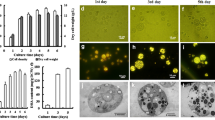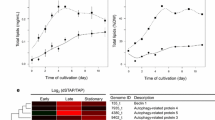Abstract
Diatoms constitute a remarkably diverse and attractive group of microalgae, serving as the main primary producers in many ecosystems and a potential source of renewable biofuel. The enhancement of lipid production in diatoms has been achieved by the optimization of culture conditions, such as temperature, salinity, and nutrient starvation. In this study, we performed Illumina sequencing and the de novo transcriptome assembly of an oleaginous diatom, Nitzschia sp., which produces up to 50 % oil by weight under defined conditions. High-quality reads were assembled into 28,117 isogenes and then subjected to BLAST alignment, Gene Ontology annotation, and KEGG Orthology annotation. The majority of genes and pathways related to cell wall formation and lipid biosynthesis were identified by these analyses. In addition, elevated salinity was found to increase the total lipid content of Nitzschia sp. For a better understanding of the molecular mechanisms regulating this phenomenon, transcriptome profiles under different conditions of salinity were compared to examine how the metabolic flux was channeled to increase the biosynthesis of triacylglycerols. As expected, a subset of genes involved in lipid biosynthesis was up-regulated under salinity stress. Meanwhile, carbon and nitrogen metabolism genes were also significantly affected, indicating a diversion of metabolic pathways. The data we generated here enrich the genomic resources available for non-model algae and provide insights into the mechanisms of lipid accumulation in microalgae.






Similar content being viewed by others
References
Field CB, Behrenfeld MJ, Randerson JT, Falkowski P (1998) Primary production of the biosphere: integrating terrestrial and oceanic components. Science 281(5374):237–240
Falkowski PG, Barber RT, Smetacek V (1998) Biogeochemical controls and feedbacks on ocean primary production. Science 281(5374):200–206
Hildebrand M (2008) Diatoms, biomineralization processes, and genomics. Chem Rev 108(11):4855–4874
Sheehan J, Dunahay T, Benemann J, Roessler P (1998) A look back at the US Department of Energy’s aquatic species program: biodiesel from algae. 328th ed. National Renewable Energy Laboratory, Golden, CO
Ramahandra TV, Mahpatra DM, Gordon R (2009) Milking diatoms for sustainable energy: biochemical engineering versus gasoline-secreting diatom solar panels. Ind Eng Chem Res 48(19):8769–8788
Mann DG, Droop SJ (1996) 3. Biodiversity, biogeography and conservation of diatoms. Hydrobiologia 336(1):19–32
Courchesne NMD, Parisien A, Wang B, Lan CQ (2009) Enhancement of lipid production using biochemical, genetic and transcription factor engineering approaches. J Biotechnol 141(1):31–41
Huang GH, Chen F, Wei D, Zhang XW, Chen G (2010) Biodiesel production by microalgal biotechnology. Appl Energ 87(1):38–46
Hu Q, Sommerfeld M, Jarvis E, Ghirardi M, Posewitz M, Seibert M et al (2008) Microalgal triacylglycerols as feedstocks for biofuel production: perspectives and advances. Plant J 54(4):621–639
Illman AM, Scragg AH, Shales SW (2000) Increase in Chlorella strains calorific values when grown in low nitrogen medium. Enzyme Microb Tech 27(8):631–635
Floreto E, Teshima S (1998) The fatty acid composition of seaweeds exposed to different levels of light intensity and salinity. Bot Mar 41(1–6):467–482
Takagi M, Yoshida T (2006) Effect of salt concentration on intracellular accumulation of lipids and triacylglyceride in marine microalgae Dunaliella cells. J Biosci Bioeng 101(3):223–226
Miller R, Wu GX, Deshpande RR, Vieler A, Gartner K, Li XB et al (2010) Changes in transcript abundance in Chlamydomonas reinhardtii following nitrogen deprivation predict diversion of metabolism. Plant Physiol 154(4):1737–1752
Armbrust EV, Berges JA, Bowler C, Green BR, Martinez D, Putnam NH et al (2004) The genome of the diatom Thalassiosira pseudonana: ecology, evolution, and metabolism. Science 306(5693):79–86
Bowler C, Allen AE, Badger JH, Grimwood J, Jabbari K, Kuo A et al (2008) The Phaeodactylum genome reveals the evolutionary history of diatom genomes. Nature 456(7219):239–244
Dunahay TG, Jarvis EE, Roessler PG (1995) Genetic transformation of the diatoms Cyclotella cryptica and Navicula saprophila. J Phycol 31(6):1004–1012
Zaslavskaia LA, Lippmeier JC, Kroth PG, Grossman AR, Apt KE (2000) Transformation of the diatom Phaeodactylum tricornutum (Bacillariophyceae) with a variety of selectable marker and reporter genes. J Phycol 36(2):379–386
Radakovits R, Jinkerson RE, Darzins A, Posewitz MC (2010) Genetic engineering of algae for enhanced biofuel production. Eukaryot Cell 9(4):486–501
Guillard RL (1975) Culture of phytoplankton for feeding marine invertebrates. In: Smith WL, Chanley MH (eds) Culture of marine invertebrate animals. Plenum, New York, pp 29–60
Grabherr MG, Haas BJ, Yassour M, Levin JZ, Thompson DA, Amit I et al (2011) Full-length transcriptome assembly from RNA-Seq data without a reference genome. Nat Biotechnol 29(7):644–652
Tang H, Wang X, Bowers JE, Ming R, Alam M, Paterson AH (2008) Unraveling ancient hexaploidy through multiply-aligned angiosperm gene maps. Genome Res 18(12):1944–1954
Xie C, Mao X, Huang J, Ding Y, Wu J, Dong S et al (2011) KOBAS 2.0: a web server for annotation and identification of enriched pathways and diseases. Nucleic Acids Res 39(suppl 2):W316–W322
Hildebrand M, Volcani BE, Gassmann W, Schroeder JI (1997) A gene family of silicon transporters. Nature 385(6618):688–689
Hildebrand M, Dahlin K, Volcani BE (1998) Characterization of a silicon transporter gene family in Cylindrotheca fusiformis: sequences, expression analysis, and identification of homologs in other diatoms. Mol Gen Genet 260(5):480–486
Thamatrakoln K, Alverson AJ, Hildebrand M (2006) Comparative sequence analysis of diatom silicon transporters: toward a mechanistic model of silicon transport. J Phycol 42(4):822–834
Sherbakova TA, Masyukova YA, Safonova TA, Petrova DP, Vereshagin AL, Minaeva TV et al (2005) Conserved motif CMLD in silicic acid transport proteins of diatoms. Mol Biol 39(2):269–280
Kroger N, Poulsen N (2008) Diatoms—from cell wall biogenesis to nanotechnology. Annu Rev Genet 42:83–107
Sumper M, Kröger N (2004) Silica formation in diatoms: the function of long-chain polyamines and silaffins. J Mater Chem 14(14):2059–2065
Poulsen N, Kröger N (2004) Silica morphogenesis by alternative processing of silaffins in the diatom Thalassiosira pseudonana. J Biol Chem 279(41):42993–42999
Guschina IA, Harwood JL (2006) Lipids and lipid metabolism in eukaryotic algae. Prog Lipid Res 45(2):160–186
Ohlrogge JB, Jaworski JG (1997) Regulation of fatty acid synthesis. Annu Rev Plant Biol 48(1):109–136
Khozin-Goldberg I, Cohen Z (2011) Unraveling algal lipid metabolism: recent advances in gene identification. Biochimie 93(1SI):91–100
Roessler PG (1990) Environmental control of glycerolipid metabolism in microalgae: commercial implications and future research directions. J Phycol 26(3):393–399
Pérez-Rodríguez P, Riaño-Pachón DM, Corrêa LGG, Rensing SA, Kersten B, Mueller-Roeber B (2010) PlnTFDB: updated content and new features of the plant transcription factor database. Nucleic Acids Res 38(suppl 1):D822–D827
Hasle GR (2004) Pseudo-nitzschia as a genus distinct from Nitzschia (Bacillariophyceae). J Phycol 30(6):1036–1039
Falkowski PG, Katz ME, Knoll AH, Quigg A, Raven JA, Schofield O et al (2004) The evolution of modern eukaryotic phytoplankton. Science 305(5682):354–360
Dagan T, Martin W (2009) Seeing green and red in diatom genomes. Science 324(5935):1651–1652
Moustafa A, Beszteri B, Maier UG, Bowler C, Valentin K, Bhattacharya D (2009) Genomic footprints of a cryptic plastid endosymbiosis in diatoms. Science 324(5935):1724–1726
Riekhof WR, Sears BB, Benning C (2005) Annotation of genes involved in glycerolipid biosynthesis in Chlamydomonas reinhardtii: discovery of the betaine lipid synthase BTA1Cr. Eukaryot Cell 4(2):242–252
Ohlrogge JB, Somerville CR (1991) The genetics of plant lipids. Biochim Biophys Acta 1082(1):1–26
Ohlrogge J, Browse J (1995) Lipid biosynthesis. Plant Cell 7:957–970
Dahlqvist A, Ståhl U, Lenman M, Banas A, Lee M, Sandager L et al (2000) Phospholipid: diacylglycerol acyltransferase: an enzyme that catalyzes the acyl-CoA-independent formation of triacylglycerol in yeast and plants. Proc Natl Acad Sci USA 97(12):6487–6492
Rismani-Yazdi H, Haznedaroglu BZ, Bibby K, Peccia J (2011) Transcriptome sequencing and annotation of the microalgae Dunaliella tertiolecta: pathway description and gene discovery for production of next-generation biofuels. BMC Genomics 12(148)
Coleman RA, Lee DP (2004) Enzymes of triacylglycerol synthesis and their regulation. Prog Lipid Res 43(2):134–176
Schwender J, Ohlrogge JB (2002) Probing in vivo metabolism by stable isotope labeling of storage lipids and proteins in developing Brassica napus embryos. Plant Physiol 130(1):347–361
Baud S, Wuillème S, Dubreucq B, De Almeida A, Vuagnat C, Lepiniec L et al (2007) Function of plastidial pyruvate kinases in seeds of Arabidopsis thaliana. Plant J 52(3):405–419
Yoshiba Y, Kiyosue T, Nakashima K, Yamaguchi-Shinozaki K, Shinozaki K (1997) Regulation of levels of proline as an osmolyte in plants under water stress. Plant Cell Physiol 38(10):1095–1102
Dickson D, Kirst GO (2006) Osmotic adjustment in marine eukaryotic algae: the role of inorganic ions, quaternary ammonium, tertiary sulphonium and carbohydrate solutes. New Phytol 106(4):645–655
Rea PA (2007) Plant ATP-binding cassette transporters. Annu Rev Plant Biol 58:347–375
Tausz M, Šircelj H, Grill D (2004) The glutathione system as a stress marker in plant ecophysiology: is a stress-response concept valid? J Exp Bot 55(404):1955–1962
Chen H, Jiang JG (2009) Osmotic responses of Dunaliella to the changes of salinity. J Cell Physiol 219(2):251–258
Azachi M, Sadka A, Fisher M, Goldshlag P, Gokhman I, Zamir A (2002) Salt induction of fatty acid elongase and membrane lipid modifications in the extreme halotolerant alga Dunaliella salina. Plant Physiol 129(3):1320–1329
Tamura K, Peterson D, Peterson N, Stecher G, Nei M, Kumar S (2011) MEGA5: molecular evolutionary genetics analysis using maximum likelihood, evolutionary distance, and maximum parsimony methods. Mol Biol Evol 28(10):2731–2739
Li L, Stoeckert CJ, Roos DS (2003) OrthoMCL: identification of ortholog groups for eukaryotic genomes. Genome Res 13(9):2178–2189
Acknowledgment
This project was supported by the National High Technology R&D Program of China (2012AA050101), National Natural Science Foundation of China (51176163), and Key Natural Science Foundation of Zhejiang Province (Z1090532).
Author information
Authors and Affiliations
Corresponding author
Electronic supplementary material
Below is the link to the electronic supplementary material.
Table S1
Primers used in qRT-PCR. (XLS 25 kb)
Table S2
Genes differentially expressed under salinity stress. (XLS 3410 kb)
Table S3
Differentially expressed genes related to C and N metabolism. (XLS 57 kb)
Fig. 1
Sequence length distribution of the Nitzschia sp. transcriptome assembly. (GIF 51 kb)
Rights and permissions
About this article
Cite this article
Cheng, Rl., Feng, J., Zhang, BX. et al. Transcriptome and Gene Expression Analysis of an Oleaginous Diatom Under Different Salinity Conditions. Bioenerg. Res. 7, 192–205 (2014). https://doi.org/10.1007/s12155-013-9360-1
Published:
Issue Date:
DOI: https://doi.org/10.1007/s12155-013-9360-1




